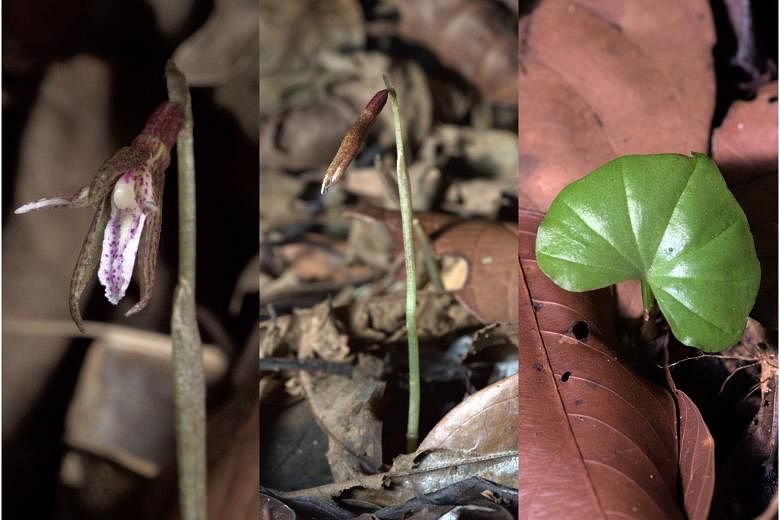A new species of orchid found in Singapore and nowhere else has been discovered at the Bukit Timah Nature Reserve.
Nervilia singaporensis was discovered by a team of researchers from the Singapore Botanic Gardens in July last year.
Growing up to 9cm tall, it has a unique oblong shape and a truncate tip.
Its flowers never really open and it self-pollinates in order to reproduce.
Dr Matti Niissalo, a researcher at the Singapore Botanic Gardens, first noticed the plant's distinctive leaves, and noted that it belonged to the Nervilia genus which, until recently, was thought to be locally extinct.
As the orchids are deciduous and its flowers usually emerge just before the next season's leaves, Dr Niissalo and his team monitored the small population of plants carefully when they began to lose their leaves.
Eventually, in November and December last year, several tiny flowers were spotted. The DNA of a plant specimen was then sequenced and compared against old herbarium records.
Only one flowering herbarium specimen was found to be from Singapore. It had been collected by the Singapore Botanic Gardens' first scientific director Henry Nicholas Ridley.
Collected in 1889 at the Bukit Timah Nature Reserve, the species had been mistakenly identified by Ridley as Nervilia punctata, a plant which is found in Java, Indonesia.
As characteristics which are critical for distinguishing the Nervilia are often obscure, the genus has been poorly collected and understood. For instance, its flowers, which are critical in its identification, last only for a few days.
Also, since the flowers and the leaves are present at different times, it is difficult to prepare specimens for herbarium collections. The plants also produce few seeds, are difficult to propagate, and are considered to be highly endangered.
Occurring widely in Africa, Oceania and Asia, the Nervilia is a genus in the Orchidaceae plant family, and is usually found growing on the forest floor.
However, it has not been studied extensively in tropical Asia. Its discovery here highlights the importance of efforts to conserve Singapore's local heritage, said experts.
Said Dr David Middleton, who is the coordinating director of research and conservation at the Botanic Gardens: "The discovery of Nervilia singaporensis shows that there is still unknown biodiversity to find and study, even in heavily urbanised Singapore.
"As such, continued efforts in documenting and learning about the richness of our habitats are crucial to protect them and their abundant biodiversity."
Blink, and you might miss this minuscule moss first spotted in NUS
The Splachnobyrum temasekensis is a tiny moss no bigger than a five-cent coin.
At around 0.5mm to 2mm long including its leaves, the plant appears to look stemless.
It is found in local urban areas but its small size and resemblance to other common species of mosses make it difficult to find.
The species was discovered in the National University of Singapore. Its name commemorates the island of Singapore and the site where it was found - on a rocky slope beside the Temasek Life Sciences Laboratory in 2003.
Rare ginger listed as critically endangered

The Zingiber singapurense, or the "Singapore ginger", was discovered in 2014 as part of a conservation project initiated by the Singapore Botanic Gardens.
Known for its spindle-shaped inflorescence, orange-red bracts and pale yellow flower, it belongs to a group of similar-looking species related to the Zingiber gracile.
To identify the then unknown species, its features were compared against two closely related species, the Zingiber auratiacum and the Zingiber elatius.
The verdict: The flowering material of the Zingiber singapurense was indeed observed to be different compared with the two, and could be considered a species of its own.
However, it is considered to be rare and classified as "critically endangered".
The plant grows in five locations in the Central Catchment Nature Reserve. The species can be propagated from cuttings and eventually planted in various other nature reserves.
Flowering herbs found in lowland forests

Two species of plants discovered in 2015 by researchers at the Singapore Botanic Gardens are flowering herbs native to Singapore.
The Hanguana rubinea is named for its ruby red, dark pink fruits that produce yellow juice when disturbed.
It grows on slopes or in proximity to small streams in partially disturbed primary lowland forests, and is found in four locations - Bukit Timah, Mandai, MacRitchie and Seletar.
The other plant is Hanguana triangulata, named for the sharply triangular shape of its stigma, which is the female part of the flower.
It is an undergrowth species found near streams in primary lowland evergreen forests, such as in Bukit Timah and Seletar.
Factors such as small populations, habitat disturbance and low numbers of adult individuals mean both species are considered critically endangered at the national and global level.


